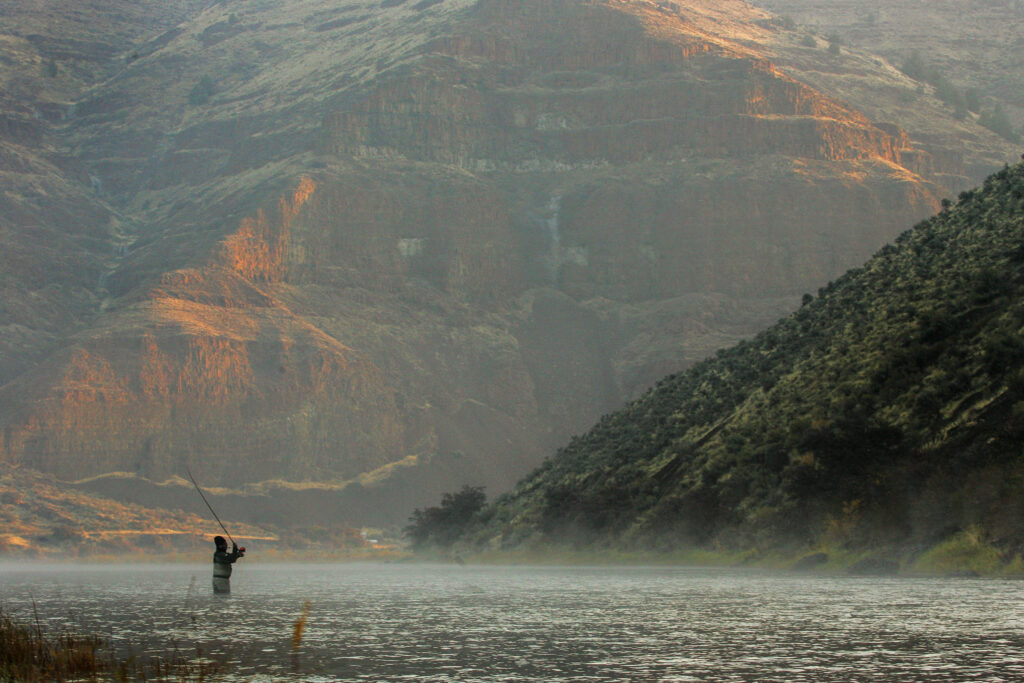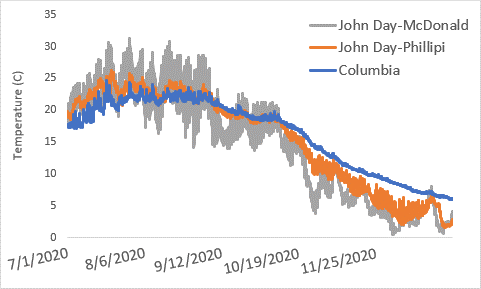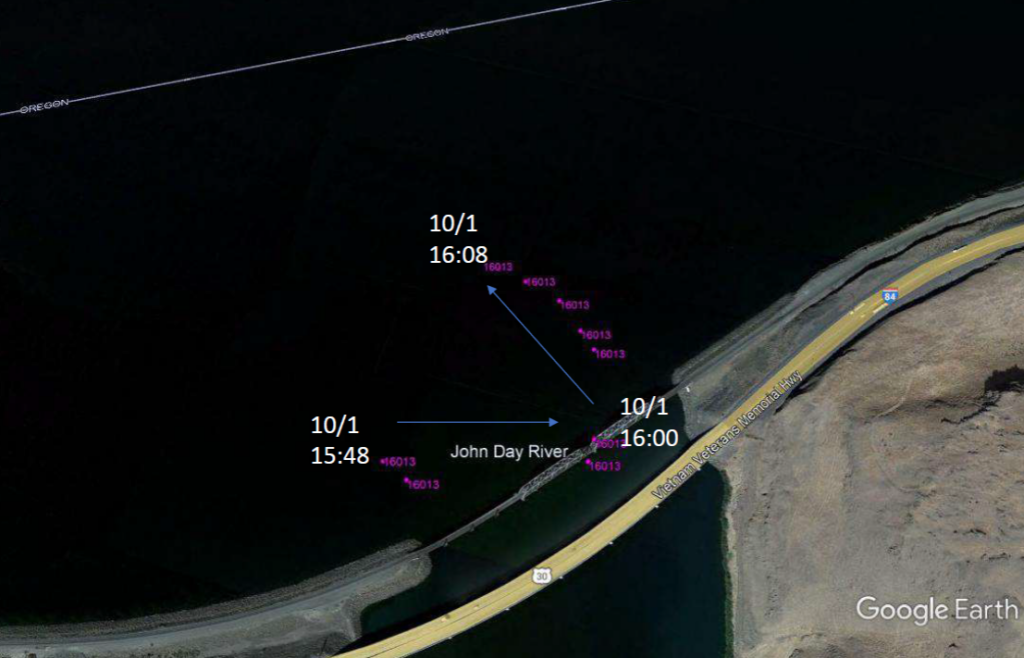
Support the next phase of the John Day Steelhead Project
In recent years, scientists and fisheries managers have become increasingly aware of the importance of coldwater refuges for summer steelhead in the Columbia River, as well as a phenomenon known as “overshooting,” where steelhead or salmon ascend one or more dams upstream of their natal tributaries. Steelhead that overshoot their natal streams must eventually pass back through the hydro system, which has downstream fish passage facilities that are not designed to accommodate adult fish. This results in many adult steelhead dying along the way without making it back to their spawning grounds.
We took a close look at overshoot steelhead, the impacts on struggling populations, and the implications for management of the basin’s hydropower system in our recent blog series: Part One and Part Two.
In many cases the need for cold water refuges and overshooting appears to be intertwined. However, in rivers such as the John Day River, which has the highest overshoot rate of any steelhead population in the basin, the mechanisms associated with overshoot are not so clear and require further directed research to fully understand.
Beginning in 2020, Wild Steelheaders United and Trout Unlimited partnered with the Oregon Department of Fish and Wildlife (ODFW) to support The John Day Steelhead Project to better understand the migration patterns of steelhead destined for the John Day River. With the support of generous individual donors, ODFW was able to acoustically tag 200 steelhead to better understand when they entered the John Day River, downstream Columbia River tributaries, or passed upstream dams, to determine how these fish use cold water refuges and determine factors associated with the John Day’s exceptionally high overshoot rate.

Along with tagging steelhead, over the course of the last year the project built a network of acoustic receivers at the confluence of the John Day and Columbia Rivers. These receivers record the movement of the tagged fish and will be used to create migration maps of their journey. These maps will help biologists better understand why so many John Day steelhead overshoot the mouth of the river. However, special analysis of the acoustic tag detection data is needed to help create those migration maps – work ODFW does not currently have funds to complete.
To support this crucial analysis and the creation of the needed migration maps, Wild Steelheaders United is currently hosting a sweepstakes to raise funds for ODFW’s work on the John Day Steelhead Project. As anglers, guides, and people who deeply admire these incredible fish, this sweepstakes offers an opportunity to directly support work that helps us better understand the fish we love.
Click here to support the project and have the chance to win a $1000 gift card to Grundéns, a guided trip on the John Day River, new waders and boots, and a box of hand-tied steelhead flies!
2023 John Day Steelhead Project Update from Ian Tattam, ODFW Fish Research Project Leader
When wild summer steelhead return to the John Day River, the majority of returning adults “overshoot,” or pass their natal river mouth and swim over McNary Dam, which is approximately 70 miles upstream. In the Columbia River basin, adult “overshoot” is most pronounced in streams with impounded river mouths, although there are some exceptions (Yakima River). The John Day River generally has the highest proportion of overshoot by returning adult steelhead.
Since the steelhead from the John Day River are “summer steelhead” and return to the Columbia River during July-August, a hypothesis of “high temperature avoidance” has been considered as an explanation for overshoot of the John Day River. Digging into this hypothesis, there are several things to consider. First; it’s important to note that overshoot is not just a steelhead issue—up to 25% of the wild Spring Chinook returning to the John Day River also overshoot past the river mouth and ascend McNary Dam. This is despite ample, cool water flow from the John Day River during May when most Chinook return, and is similar to Spring Chinook overshoot of the Tucannon River in Southeast Washington (another impounded river confluence). This suggests there are structural factors beyond just tributary stream flow and temperature that influence overshoot in the John Day River and hence warrant further research to inform management experiments.
After John Day steelhead pass Bonneville Dam on their upstream migration, they split into two migratory modes. Some steelhead (especially those migrating early in July while the Columbia River remains cooler than 68° F) arrive at John Day River mouth in only a few days. Conversely, others (especially those crossing Bonneville Dam when the Columbia is warmer than 68° F) migrate much more slowly, and don’t cross John Day Dam until mid-September through late October.

With support from Wild Steelheaders United, Trout Unlimited and others, we have acoustic tagged adult steelhead in the Columbia River to help study the movement of these two migratory modes individually. Catch up on this work in a previous blog post.
We learned that some of the early-arriving steelhead did find and enter the impounded portion of the John Day River during July, but then turned around and went downstream to the Deschutes River for the summer. They then returned to the John Day River in one or two days of migration during October. So, these fish are avoiding the high summer temperature in the John Day River via ‘behavioral thermoregulation,’ but not by overshooting.
In contrast to the early migrating mode, the majority of adult steelhead don’t arrive at the John Day River mouth until September and October. In most years, within a week or two after Labor Day, stream temperature in the John Day River is actually cooler than in the Columbia due to the larger thermal inertia in the Columbia. Most of the steelhead arriving during these months overshoot.

With the acoustic telemetry data collected to describe adult steelhead migration patterns during 2020, we observed that—for steelhead that ultimately spawn in the John Day —54% never entered the river mouth prior to overshooting. The slower migrating mode of the adult steelhead are not avoiding the river due to high temperature—because they never entered and ‘sampled’ it!
During 2022-2023, we operated a more extensive network of acoustic receivers at the confluence of the John Day and Columbia. The goal of this receiver network is to build expanded and improved maps of the migration routes that individual steelhead take through this area. Our long-term goal is to relate these migration patterns to river current patterns near the mouth of the John Day River to develop a mechanistic understanding of why so many John Day origin steelhead and Chinook overshoot the river mouth.

The John Day River is the longest undammed tributary to the Columbia River, has no hatchery releases and historically hosted one of the most robust wild steelhead populations in the basin. This year, the river’s catch and release fishery will open for the first time in two years with over 26,000 fish passing over Bonneville Dam. In recent years, returns have been too low for managers to open the fishery. With the exceptionally high overshoot rates and mortality associated with steelhead falling back downstream through the hydro system, understanding the mechanisms associated with overshoot in the basin are essential to ensuring the long-term viability, and recovery of the population.
To do this, ODFW first needs to raise the funds for contracting the specialized analysis of acoustic tag detection data for building updated migration maps. These maps then allow managers to relate individual steelhead migration patterns to environmental characteristics and develop mechanistic hypotheses to explain the factors driving steelhead and salmon overshoot of the John Day River.
Help ODFW and Wild Steelheaders United complete this research and gain a better understanding of the John Day’s wild summer steelhead by supporting the project and entering for your chance to win a $1000 gift card to Grundéns, a guided trip on the John Day River, and more!


